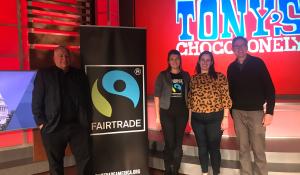
HopeWorks Station in Everett, Washington, has been drawing attention for its multiple areas of socially conscious innovation. The LEED Platinum-certified development integrates 65 affordable apartments for low-income households and those recovering from addiction alongside supportive services, job training, a child-care center, and community meeting space. People who were once homeless and struggling with alcohol- or drug-related issues live on the upper floors and go downstairs to work at Kindred Kitchen, a catering business and community café, or at the business next door, RENEW Home & Décor—all within the same complex.
The innovation behind HopeWorks extends to how it was financed. Affordable housing is usually funded by multiple sources, including large investment companies through Low Income Housing Tax Credits and other federal programs. HopeWorks was financed through a mission-driven nonprofit organization, Enterprise Community Partners, which included financing from its Enterprise Community Loan Fund, a community development financial institution (CDFI).
Individuals interested in investing in innovative projects that reflect their values, like HopeWorks, can do so through financial products offered by CDFIs, like Enterprise. Enterprise's Community Impact Note helped finance the HopeWorks project. Proceeds from the Impact Note support the organization’s general lending work (about 70% goes to affordable housing), with money loaned to nonprofit and mission-aligned for-profit developers.
HopeWorks Station represents a meaningful case study to Anna Smukowski, director of the Enterprise Community Loan Fund, because it shows how CDFI funding works alongside other more conventional sources of capital from Enterprise. “We’re providing funding to communities but also allowing individual people to get more invested in their communities, people who want to live their values through their investments,” Smukowski says.
Investment in the Enterprise Community Impact Note is open to people around the country, for a minimum investment of $5,000. However, many CDFIs and community-focused lenders offer even lower entry points for their financial products—including as little as $20 (see box on p. 21).
The Role of CDFIs and Community-Focused Lenders
Environmental and social impact investing has become part of the investment mainstream recently, and CDFIs have an important role, according to the “CDFIs and the Capital Markets” white paper, cowritten by Smukowski, alongside other writers from Enterprise and the Local Initiatives Support Corporation.
“CDFIs now have the opportunity to position the industry as the ultimate impact investment, capable of addressing key social and environmental issues like the acute affordable housing crisis; persistent racial health, wealth, and opportunity gaps; and environmental sustainability measures in low-income and historically underserved communities,” Smukowski and her co-authors say. CDFIs are required to report on impacts on a regular basis, an opportunity to tell the stories about how communities are affected by these investments.
When you invest in community-focused products like the examples in this article, you can earn a rate of return for yourself, while also supporting important community-building projects. For example, the Connecticut Green Bank, which accepts minimum investments of just $100, works with families, businesses, houses of worship, and other community groups to develop clean-energy solutions from solar photovoltaic installations to energy-efficiency retrofits and green-building projects.
The Benefits of Impact Investing
With socially responsible investing, you can align your investments with impacts you care about whether it’s creating affordable housing, mitigating climate change, or supporting business owners who have been left out of conventional lending. Sometimes multiple issues that investors care about intersect in one responsible project, such as the HopeWorks project combining affordable housing, sustainable design, proximity to transit, job training, and reducing homelessness.
Brady Quirk-Garvan of Natural Investments, a social investing advisory group, described how he has helped some investors combine their interest in affordable housing with a desire to support business ventures led by women, such as Shortstack Housing in Portland, Oregon: “It’s woman-owned and run and focuses on ‘missing middle’ housing [such as duplexes and townhomes] … that is affordable, near public transit, and that will remain affordable for decades.”
How to Get Started with Impact Investing
An easy first step for getting involved with community investing is to first open a checking or savings account with a CDFI or other responsible bank or invest in a certificate of deposit (CD).
As a next step, consider investment vehicles with lower minimum requirements, like the Community Investment Note, issued by Calvert Impact Capital, a community development organization that supports and partners with CDFIs. This gateway investment for individuals getting started with impact investing offers an entry point of just $20. In Calvert Impact’s 2022 survey of their investors, 54% said it was their first cause-based investment.
Capital from the note has supported a wide range of projects including Artspace, affordable live-work spaces for artists across the US; Central City Concern, which offers housing, health, recovery, and employment support in Portland, Oregon; and Self-Help Enterprises, which provides home-ownership support to farmworkers and other hard-working families in California’s San Joaquin Valley.
The Connecticut Green Bank’s Green Liberty Bonds and Notes—inspired by Green America’s Clean Energy Victory Bonds campaign—offers similarly accessible investments priced at $100 and $1,000, to fund local clean-energy projects. The Enterprise Community Impact Note is another effective way to get started investing with a community development financial institution.
Finally, if you have the means, and wish to directly invest in specific responsible community-building projects, consider consulting an individual investment advisor, like Quirk-Garvan at Natural Investments, who can match options with your values and the amount you plan to invest.
Whichever vehicle you choose, you can feel confident when you seek out a mission-focused financial product that your investment dollars are doing good in the world.









